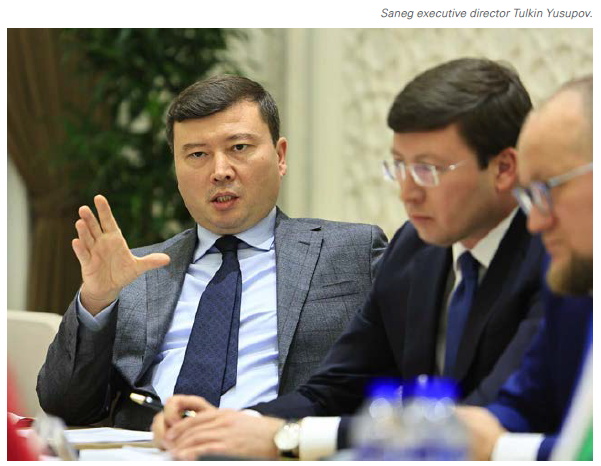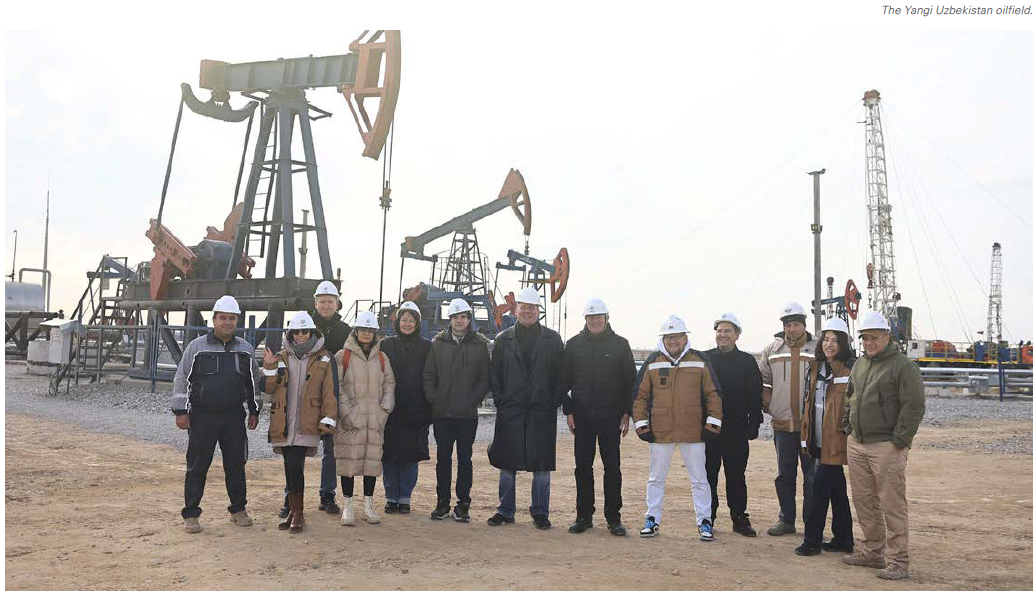Saneg: driving oil and gas development in Uzbekistan [Gas in Transition]
Uzbekistan is moving forward with a series of projects to modernise and expand its oil and gas industry. Taking the lead in this effort is Sanoat Energetika Guruhi (Saneg), the country’s largest private oil and gas company. Saneg’s investments, competent management decisions and focus on strategic long-term objectives are producing tangible results, executives told NGW in early December, during a trip that the company organised to its operational sites.
Established as Jizzakh Petroleum in 2017, the company rebranded itself as Saneg in November 2022 and went on to buy the previously state-owned Fergana oil refinery in June 2022.
“The new umbrella brand is integral to the company’s modernisation, indicating the transformation towards a new management model: vertical integration,” Saneg’s executive director, Tulkin Yusupov, said. “We want to show a new face to our current and prospective partners – an external brand reflecting the internal values.”
Saneg has built up its large operation in very little time. The licences and subsoil rights to develop 103 oil and gas fields across Uzbekistan were transferred to the company in 2019, containing 762.5mn metric tons of oil and 127bn 3 of gas of natural gas. About 52% of the company’s resource base is classified as undergoing development, while a further 48% is at the exploration stage. There are 769 wells.
Saneg’s current oil and gas production is relatively modest by the standards of other major Central Asian oil and gas producers – around 586,400 mt of oil and 1.5bn m3 of gas in 2022. But the company plans to expand this output by the end of the decade to 1.6mn mt of hydrocarbon liquids and 5bn m3 of gas. A part of this plan is the Yangi Uzbekistan field project, with a cost of $2.5bn over its first ten years and set to produce 1mn mt/yr of bitumen by 2025. Beyond developing new fields, Saneg is also restoring previously abandoned wells – 57 since 2019. It plans to commission a further 180 wells in 2023.
The company is also making investments downstream, in line with Uzbekistan’s strategy of extracting greater value from its oil and gas reserves and substituting imports. Its two flagship projects in this area are the modernisation of the Fergana oil refinery and a planned methanol-to-olefins (MTO) complex in the Bukhara region.
‘Within the cluster model integrated into the economy of Uzbekistan by president Shavkat Mirziyoyev and the national policy of focusing on the domestic market, our vertical integration is market-oriented and is built, with the assistance of experts, on a complete chain from extraction to the delivery to consumers,” Azizbek Nazarov, deputy executive director for field development at Saneg, told NGW. “Our target is to cover the needs of the domestic market with locally produced products that meet quality standards. But also, we have plans to export our products of deep processing – after satisfying the needs of the domestic market.”
In February this year, Saneg expects to receive the results of Argus Media market research on oil products across Central Asia, so that it can invest in balancing production with regional demand.
Fergana oil refinery
Built in 1959, the Fergana oil refinery has not been modernised since the collapse of the Soviet Union. Saneg took over the plant in 2020 and launched a modernisation programme in July last year worth over $400mn. The refinery comprises 35 technological units and produces around 60 different products, which it delivers both to the local market and 15 foreign countries. It refines about 1mn mt of hydrocarbons annually, although its capacity is much greater.
In the near term, the aim is to double throughput at the Fergana plant to 2mn mt/yr, by modernising its facilities and also ramping up production at the Yangi Karatepa oilfield that supplies it. The field is now flowing 90 mt of oil daily, which is almost 40 times higher than its output two years ago.
“The Yangi Karatepa field is not new, but it has good potential, so that allows us to increase production rates at the Fergana oil refinery, especially now, when the fuel situation is critical,” Yusupov explained. “We will continue to apply modern methods of geophysical surveys, as well as advanced technologies for prospecting and recovering oil.”
There has been a considerable increase in fuel demand in Uzbekistan, partly as a result of the government’s recent abolition of excise tax, the refinery’s CEO, Khabib Latipov, explained. The refinery’s workload has been adjusted to be ready for current winter demand, he said, and all its gasoline will be sold on the exchange, at a free market price, as stipulated by the legislation of the country.
The quality of the refinery’s fuel will also be improved, with Saneg set to begin production of Euro-5 gasoline by 2024.
Saneg’s modernisation programme will wrap up in 2024, with the first major new units scheduled for start-up at the end of this year.
MTO
The $3bn MTO project (GSS MTO) in Bukhara is unique for Central Asia. It will refine 1.3bn m3/year of methane into 730,000 mt of polymers, including polyethylene terephthalate, polypropylene and ethylene vinyl acetate. The output of these high-value products is more than enough to satisfy domestic demand, and spare volumes can be exported to other CIS countries, Turkey, China and southeast Asia.
A front-end engineering design study has been commissioned from Wood, and a technical and economical assessment and sales strategy are being developed. In December, Mott McDonald also completed an environmental and social impact assessment (ESIA), confirming that the project satisfies international standards. The ESIA also confirmed the project’s value to the local economy, estimating that it would result in 2,000 direct and 10,000 indirect jobs.
‘We thank the experts at Mott MacDonald and Ekostandart Ekspert for their competent assessment, which will facilitate the implementation of the project in the most responsible way,” the project’s general director, Masrur Shakirov, commented. “From the very beginning of our large, and regionally unique, industrial project, we have committed to international standards of environmental and social sustainability.”
The project is based at the Karakul Free Economic Zone (FEZ), giving it tax privileges. But it will still generate an billions of dollars in tax for Uzbekistan over two decades.
ESG
Nazarov acknowledges that environmental standards in Uzbekistan’s oil and gas industry fall short of those in some Western countries. But Saneg is looking to address this at its own operations, setting targets and cooperating with international experts to ensure that they are reached.
Saneg has managed to reduce flaring by 250,000 mt of methane, selling the gas instead of simply burning it. It has completely eliminated flaring at two fields – North Urtabulak and Shurtan (Karshi region). It has also applied for a green certificate, to prove how much of the power it uses is generated by renewables.
 “Being concerned with the pollution issues and working with about 40 international consultants, we aim at using green technologies, including environmentally friendly technologies such as the acid test adopted from the Canadian experience,” Yusupov said. “Additionally, we attract investments for installing photovoltaic systems on the fields to provide electricity for production needs.”
“Being concerned with the pollution issues and working with about 40 international consultants, we aim at using green technologies, including environmentally friendly technologies such as the acid test adopted from the Canadian experience,” Yusupov said. “Additionally, we attract investments for installing photovoltaic systems on the fields to provide electricity for production needs.”
Technologies
“Today we understand that many of the fields where we produce oil and gas cannot show results without new technologies. Unfortunately, the closed nature of the country in earlier periods meant that technology companies did not enter the upstream and middle stream segments. Today the situation is changing dramatically, thanks to the reforms of the country's leadership, Uzbekistan has become an open country for many companies,” Saneg’s director of corporate communications, Igor Gusenkov, said. “In this regard, we are now launching the ‘Open Land’ project to attract the latest technologies in the field of oil production. These are solutions in the field of petrochemistry, and technologies for enhanced oil recovery, and horizontal drilling, and hydraulic fracturing – and many others. We are open to cooperation not only with the largest oilfield services companies such as Halliburton, Baker Hughes, Schlumberger and Weatherford, but also with technology startups and young teams that offer new technologies in the upstream and midstream segments. For them, we are ready to provide preferential terms, including in the field of testing our technologies at our wells. Very soon this project will be presented to the general public.”
Saneg became the first Central Asian company to implement a US well survey technology – video-logging. Provided by Downhole Vision, this diagnostic method not only reduces the risk of accidents by up to 95%, but also cuts production costs and financial losses since less advanced technology is more time- and labour consuming. Moreover, the well in the North Urtabulak field, previously decommissioned, has been restored thanks to the use of the video-logging technology.
“This new method of visual inspection of well heads is effective for provision of safety, optimisation of resources and production process,” Sergey Ryabov, chief engineer of Saneg, said. “Providing an objective assessment, video-logging technology will have a direct impact on increasing the efficiency of extracting raw hydrocarbons.”
Saneg has also been cooperating with Geo Research and Development (GRDC) since 2019, resulting in over 50 project solutions over the last two and a half years, according to Yusupov. GRDC conducts geo-technical assessments and above-ground engineering to model oil and gas fields, including with the use of its three-dimensional geological and hydrodynamic modelling technology called tNavigator. This enables seismic risk to be assessed at fields – an important consideration given the high level of seismicity in Uzbekistan.
Investment climate
Since president Mirziyoyev came to power in late 2016, Uzbekistan has undergone a rapid economic transformation. Its markets have become more liberalised and there has been a greater focus on attracting foreign investment, by eliminating various barriers for businesses. These efforts have already yielded results, Saneg executives said.
In 2019, the government set up a Foreign Investors Council with the support of the European Bank for Reconstruction and Development (EBRD), designed to serve as a platform for direct dialogue with investors operating in Uzbekistan. That same year a new law on investment was introduced, which simplified regulation and provided various support mechanisms such as investment tax credits and investment subsidies.
“There have been major changes in infrastructure, tax policy and the banking sector,” said Nazarov. “The reforms of recent years have led to great benefits for investors. Free economic clusters have been formed with privileges in terms of exemptions from excises, customs duties, subsoil taxes, property taxes etc.”
“The country has openly broken into the global market,” Yusupov added. “As a big representative of the oil and gas sector, we can state there have been considerably positive changes in the investment climate, as evidenced by the realisation of our large projects.”
Indeed, the bulk of the investment funding the Fergana and MTO projects was sourced internationally.
While Uzbekistan’s investment climate has clearly improved, Saneg cautions that more work is needed to increase private investment, including by liberalising entrepreneurial activity further.



